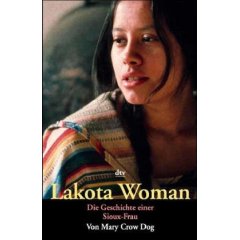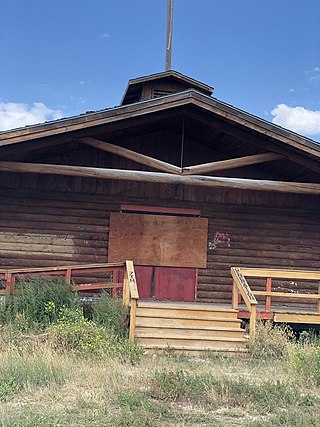This biographical article needs more biographical information on the subject.(April 2014) |
Henry Crow Dog was a Rosebud Indian Reservation Sioux medicine man who resided on his land, Crow Dog's Paradise. [1]
This biographical article needs more biographical information on the subject.(April 2014) |
Henry Crow Dog was a Rosebud Indian Reservation Sioux medicine man who resided on his land, Crow Dog's Paradise. [1]
In 1970, Henry Crow Dog introduced Dennis Banks, a Leech Lake Indian Reservation Ojibwe and leader of the American Indian Movement, about Lakota religion. [2] [3] Dennis Banks sought out Henry Crow Dog for this purpose after he realized that he and most of AIM had very little Native American spiritual knowledge or guidance. [4] Crow Dog then taught Banks the Inipi, Yuwipi, and Sun Dance ceremonies. [5] Henry Crow Dog's son, Leonard Crow Dog, soon became the spiritual leader of AIM and Crow Dog's Paradise soon became a meeting place for the organization. [6]

The Crow, whose autonym is Apsáalooke, also spelled Absaroka, are Native Americans living primarily in southern Montana. Today, the Crow people have a federally recognized tribe, the Crow Tribe of Montana, with an Indian reservation located in the south-central part of the state.

The Cheyenne are an Indigenous people of the Great Plains. Their Cheyenne language belongs to the Algonquian language family. Today, the Cheyenne people are split into two federally recognized nations: the Southern Cheyenne, who are enrolled in the Cheyenne and Arapaho Tribes in Oklahoma, and the Northern Cheyenne, who are enrolled in the Northern Cheyenne Tribe of the Northern Cheyenne Indian Reservation in Montana. The Cheyenne comprise two Native American tribes, the Só'taeo'o or Só'taétaneo'o and the Tsétsêhéstâhese. The tribes merged in the early 19th century.

William John Janklow was an American lawyer and politician and member of the Republican Party who holds the record for the longest tenure as Governor of South Dakota: sixteen years in office. Janklow had the third-longest gubernatorial tenure in post-Constitutional U.S. history at 5,851 days.

The American Indian Movement (AIM) is a Native American grassroots movement which was founded in Minneapolis, Minnesota in July 1968, initially centered in urban areas in order to address systemic issues of poverty, discrimination, and police brutality against Native Americans. AIM soon widened its focus from urban issues to many Indigenous Tribal issues that Native American groups have faced due to settler colonialism in the Americas. These issues have included treaty rights, high rates of unemployment, Native American education, cultural continuity, and the preservation of Indigenous cultures.

John Fire Lame Deer was a Lakota holy man, member of the Heyoka society, grandson of the Miniconjou head man Lame Deer, and father of Archie Fire Lame Deer.

The Sioux Wars were a series of conflicts between the United States and various subgroups of the Sioux people which occurred in the later half of the 19th century. The earliest conflict came in 1854 when a fight broke out at Fort Laramie in Wyoming, when Sioux warriors killed 31 American soldiers in the Grattan Fight, and the final came in 1890 during the Ghost Dance War.

Dennis Banks was a Native American activist, teacher, and author. He was a longtime leader of the American Indian Movement, which he co-founded in Minneapolis, Minnesota in 1968 to represent urban Indians.
Mary Brave Bird, also known as Mary Brave Woman Olguin and Mary Crow Dog was a Sicangu Lakota writer and activist who was a member of the American Indian Movement during the 1970s and participated in some of their most publicized events, including the Wounded Knee Incident when she was 18 years old.

Frank Fools Crow was an Oglala Lakota civic and religious leader. 'Grandfather', or 'Grandpa Frank' as he was often called, was a nephew of Black Elk who worked to preserve Lakota traditions, including the Sun Dance and yuwipi ceremonies. He supported Lakota sovereignty and treaty rights, and was a leader of the traditional faction during the armed standoff at Wounded Knee in 1973. With writer Thomas E. Mails, he produced two books about his life and work, Fools Crow in 1979, and Fools Crow: Wisdom and Power in 1990.

Lakota Woman is a memoir by Mary Brave Bird, a Sicangu Lakota who was formerly known as Mary Crow Dog. Reared on the Rosebud Indian Reservation in South Dakota, she describes her childhood and young adulthood, which included many historical events associated with the American Indian Movement.

The Wounded Knee Occupation, also known as Second Wounded Knee, began on February 27, 1973, when approximately 200 Oglala Lakota and followers of the American Indian Movement (AIM) seized and occupied the town of Wounded Knee, South Dakota, United States, on the Pine Ridge Indian Reservation. The protest followed the failure of an effort of the Oglala Sioux Civil Rights Organization (OSCRO) to use impeachment to remove tribal president Richard Wilson, whom they accused of corruption and abuse of opponents. Additionally, protesters criticized the United States government's failure to fulfill treaties with Native American people and demanded the reopening of treaty negotiations to hopefully arrive at fair and equitable treatment of Native Americans.

Archie Fire Lame Deer or Tȟáȟča Hušté (1935–2001) was a US Army veteran, a Wicasa Wakan or Medicine man and a lecturer on Lakota people, traditions and religion. He grew up on the Rosebud Indian Reservation served in the US Army during the Korean war, was a Hollywood stuntman and translator. With Richard Erdoes he wrote Gift of Power: the life and teachings of a Lakota medicine man. He is the son of John Fire Lame Deer Lakota Medicine Man and the subject of the classic book, "Lame Deer Seeker of Visions” with Richard Erdoes.

Crow Dog was a Brulé Lakota subchief, born at Horse Stealing Creek, Montana Territory.

Medicine Rocks State Park is a park owned by the state of Montana in the United States. It is located about 25 miles (40 km) west-southwest of Baker, Montana, and 11 miles (18 km) north of Ekalaka, Montana. The park is named for the "Medicine Rocks," a series of sandstone pillars similar to hoodoos some 60 to 80 feet high with eerie undulations, holes, and tunnels in them. The rocks contain numerous examples of Native American rock art and are considered a sacred place by Plains Indians. As a young rancher, future president Theodore Roosevelt said Medicine Rocks was "as fantastically beautiful a place as I have ever seen." The park is 330 acres (130 ha) in size, sits at 3,379 feet (1,030 m) in elevation, and is managed by the Montana Department of Fish, Wildlife and Parks. It was listed on the National Register of Historic Places in 2017 and designated as a certified International Dark Sky Sanctuary in 2020.
Leonard Crow Dog was a medicine man and spiritual leader who became well known during the Lakota takeover of the town of Wounded Knee on the Pine Ridge Indian Reservation in South Dakota in 1973, known as the Wounded Knee Incident. Through his writings and teachings, he has sought to unify Indian people of all nations. As a practitioner of traditional herbal medicine and a leader of Sun Dance ceremonies, Crow Dog was also dedicated to keeping Lakota traditions alive.

Jancita Eagle Deer was a Brulé Lakota who lived on the Rosebud Indian Reservation in South Dakota. She was notable for accusing William Janklow of having raped her in January 1967 when he was a poverty lawyer and Director of the Rosebud Sioux Legal Services program on the reservation. She had worked as his babysitter. At the time the Bureau of Indian Affairs (BIA) and the Federal Bureau of Investigation (FBI) did not prosecute the case.
Richard Erdoes was an American artist, photographer, illustrator and author.

The Great Sioux Nation: Sitting in Judgment on America is a book edited by Roxanne Dunbar-Ortiz, "An Oral History of the Sioux Nation and Its Struggle for Sovereignty", that documents the 1974 "Lincoln Treaty Hearing". Testimony produced during that hearing has been cited by the International Indian Treaty Council in advocating for Indigenous sovereignty and treaty rights, efforts which eventually saw the 2007 Declaration on the Rights of Indigenous Peoples.
Lorelei DeCora Means, born Lorelei De Cora, was a Native American nurse and civil rights activist. She is best known for her role in the second siege in the town of Wounded Knee, South Dakota, on the Pine Ridge Indian Reservation. She was also a co-founder of the American Indian organization, Women of All Red Nations.
Ellen Moves Camp, was an Oglala woman who played a critical role in activism for Indians in America. Her name became prevalant in history when Dick Wilson, a chairman elected to oversee their reservation, started heavily persecuting the Native Americans that lived there. Moves Camp and other full-blood elders started to rally their peers and supporting groups such as the American Indian Movement (AIM) to stand up against the government. After further oppression, they met at Calico hall where multiple older women including Moves Camp urged the men to act, and planned a siege at Wounded Knee known as the Wounded Knee Occupation. This siege drew a lot of public attention, and through it, those at Pine Ridge were able to receive funding and support throughout trials and movements made from then on. Moves Camp died in 2008 at the Pine Ridge reservation after dedicating years of her life to raising awareness for her people and instilling movement into those around her.